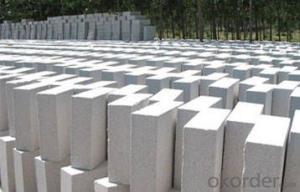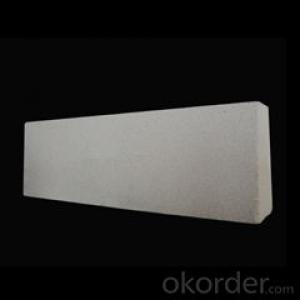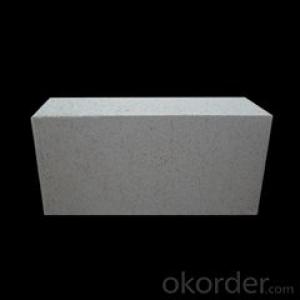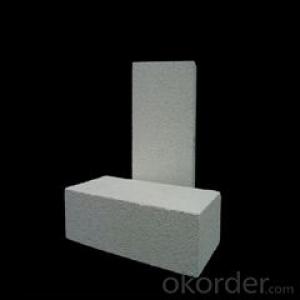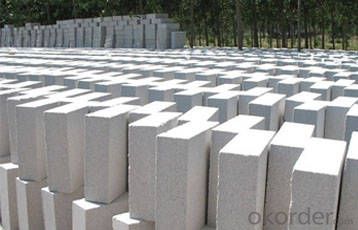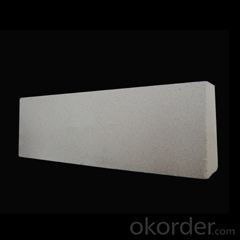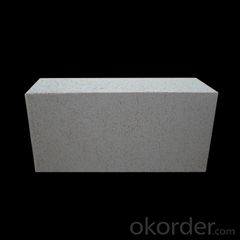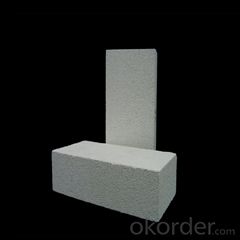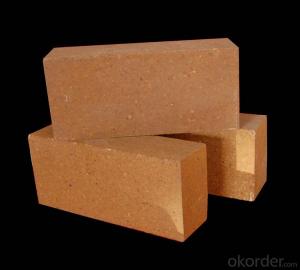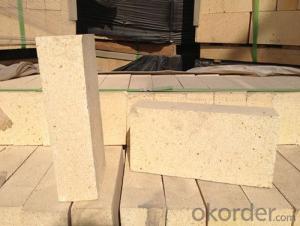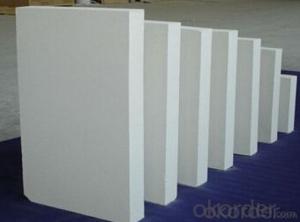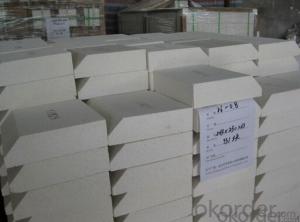Insulating Fire Brick - Refractory Mullite Insulating Refractory Brick JM 97
- Loading Port:
- Shanghai
- Payment Terms:
- TT OR LC
- Min Order Qty:
- 5000 kg
- Supply Capability:
- 10000 kg/month
OKorder Service Pledge
OKorder Financial Service
You Might Also Like
Refractory mullite insulating refractory brick JM 23
Okorder series heat insulation brick
Okorder series thermal insulation brick is an effective, energy saving, low carbon, environmental protection advanced, according to the ASTM standard manufacturing products. Okorder series products are best Li Ning and insulation in all types of industrial furnaces in the metallurgical field, aluminum, petrochemical, electric power and glass ceramic materials. They can be used as part of the working layer of thermal insulation or non - melting. Products have been widely used in the following furnace, achieved satisfactory results.
Application of heat preservation brick
Metallurgical Industry: blast furnace, hot blast furnace, heating furnace, etc..
Petrochemical Industry: ethylene cracking furnace, hydrogen production furnace, primary reformer, heating furnace, etc..
Ceramic industry: roller kiln, kiln, etc..
Glass industry: glass furnace regenerator, etc.
Carbon industry: carbon furnace, etc..
Aluminum electrolysis industry: aluminum reduction cell, etc.
Other industries: tunnel kiln, shuttle kiln, etc..
Advantages of heat insulation brick
Low thermal conductivity: more porosity will bring good thermal insulation effect, energy saving.
High crushing strength: high crushing strength, volume stability.
Low heat storage: small heat storage to absorb more heat, energy-saving effect is obvious.
Gao Chundu: iron, alkali metal impurity content is low.
The precise size: Brick size processing precision, special shape cutting and grinding, accelerate the brickwork.
Insulating brick picture
Common problem solutions
1. What products do you have?
We have all kinds of refractory bricks, refractory casting materials, mortar, cement, ceramic fiber products, etc..
Or you can browse our products to choose what you need.
2. How to control product quality?
With strict quality control system throughout the material selection and production process, we have the quality of refractory materials and ceramic fiber products to meet customer requirements.
From the selection of raw materials, the quality of our control to start. The quality certificate of the raw material is required, each batch of the products are to be tested in the use of the forward line. In the production process, the quality control by the workers, and then each piece of classification, and through the quality supervision and inspection.
3. Can you give me a brief introduction to the application of your product?
My company is mainly engaged in refractories in the steel, cement, glass, ceramics, petrochemical, electric power and other industries.
4. What information do you need if I need you?
In order to select the right products, we will provide us with information, such as the United States, technical data, order quantity, product application, etc..
If you have any questions, please contact us.
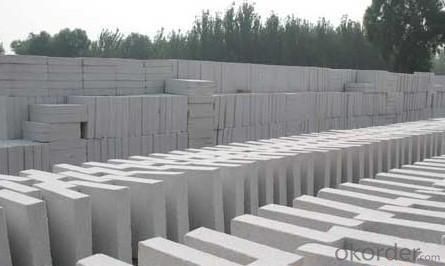
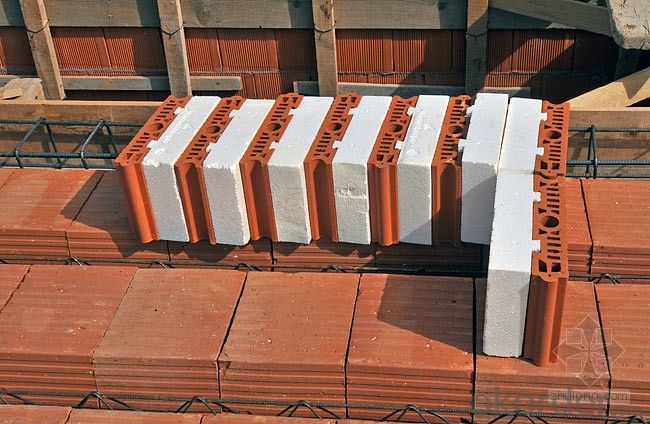
- Q: Can insulating fire bricks be used as a backup insulation in refractory linings?
- Yes, insulating fire bricks can be used as a backup insulation in refractory linings. They are designed to withstand high temperatures and provide excellent thermal insulation properties, making them suitable for this purpose.
- Q: Can insulating fire bricks be used in cryogenic applications?
- Insulating fire bricks, also known as refractory bricks, serve primarily for high-temperature purposes and find common usage in furnaces and kilns. Nonetheless, when it comes to cryogenic applications involving extremely low temperatures, insulating fire bricks may prove to be unsuitable. Cryogenic temperatures, usually below -150 degrees Celsius (-238 degrees Fahrenheit), present distinctive challenges for materials due to the severe thermal stresses they endure. Insulating fire bricks typically consist of materials like alumina and silica, which possess limited resistance to thermal shock and can become brittle at exceedingly low temperatures. This brittleness exposes them to the risk of cracking and failure under cryogenic conditions. Furthermore, insulating fire bricks exhibit relatively high thermal conductivity, implying that they conduct heat rather efficiently. In cryogenic applications, where minimizing heat transfer is of utmost importance, materials with lower thermal conductivity are preferred. Consequently, insulating fire bricks, with their higher thermal conductivity, may not be the most effective choice for cryogenic applications. Instead, materials with exceptional thermal insulation properties and low thermal conductivity, like aerogels or foams made from silica or carbon, are often favored for cryogenic applications. These materials offer superior thermal insulation and better resistance to extreme temperatures, ensuring efficient and dependable performance in cryogenic environments. In conclusion, while insulating fire bricks find suitability in high-temperature applications, they may not be the optimal selection for cryogenic applications due to their brittleness at low temperatures and relatively high thermal conductivity. Materials specifically designed for cryogenic conditions, such as aerogels or foams, prove to be more suitable for these extreme temperature environments.
- Q: Are insulating fire bricks resistant to cracking under pressure?
- Insulating fire bricks exhibit resistance to cracking when subjected to pressure. They are specifically engineered to endure elevated temperatures and mechanical strain. Composed of lightweight materials with low thermal conductivity, like ceramic fiber or lightweight aggregates, these bricks maintain their structural integrity even under pressure or thermal expansion. Moreover, insulating fire bricks typically possess a significant alumina content, enhancing their strength and crack resistance. These qualities make them an excellent choice for applications requiring insulation and structural stability, such as furnaces, kilns, and high-temperature industrial processes. Nevertheless, it is crucial to acknowledge that excessive pressure or abrupt temperature changes can still harm insulating fire bricks. Thus, it is essential to adhere to proper installation and maintenance guidelines to ensure their durability and performance.
- Q: Can activated carbon be antiseptic?
- Activated carbon is mainly with adsorption properties, there is no direct anti-corrosion effect.
- Q: Can insulating fire bricks be used in the construction of lime production ovens?
- Yes, insulating fire bricks can be used in the construction of lime production ovens. These bricks are designed to withstand high temperatures and provide excellent insulation, making them suitable for the intense heat and thermal requirements of lime production ovens. They help maintain consistent temperature levels, reduce heat loss, and improve energy efficiency, making them a reliable choice for such applications.
- Q: Can insulating fire bricks be used in the construction of refractory coatings?
- Yes, insulating fire bricks can be used in the construction of refractory coatings. Insulating fire bricks are designed to have low thermal conductivity, which means they are excellent at preventing heat transfer. This makes them ideal for use in refractory coatings, which are used to protect structures from high temperatures. Refractory coatings are applied to surfaces that are exposed to extreme heat, such as furnaces, kilns, and chimneys. These coatings provide a layer of insulation that helps to retain heat, prevent damage to the underlying structure, and improve energy efficiency. Insulating fire bricks can be used as a base layer in the construction of refractory coatings. They can be stacked and bonded together to form a solid and heat-resistant surface. This layer acts as a barrier to prevent heat from transferring through to the underlying structure. In addition to their low thermal conductivity, insulating fire bricks also have other properties that make them suitable for use in refractory coatings. They have high temperature resistance, meaning they can withstand the extreme heat generated in industrial applications. They are also lightweight and easy to handle, making them convenient to install and work with. Overall, insulating fire bricks are a reliable option for constructing refractory coatings. They provide excellent insulation and protection against high temperatures, making them a valuable component in the construction of heat-resistant structures.
- Q: Can insulating fire bricks be used for fireplace lining?
- Yes, insulating fire bricks can be used for fireplace lining. These bricks are designed to withstand high temperatures and provide excellent insulation, making them suitable for lining the inside of a fireplace. They help to retain heat and improve the efficiency of the fireplace while protecting the surrounding structure from excessive heat.
- Q: What temperature can insulating fire bricks withstand?
- Insulating fire bricks possess the capability to endure high temperatures, typically ranging from 2,200 to 3,000 degrees Fahrenheit (1,200 to 1,650 degrees Celsius). These bricks are engineered with the specific purpose of delivering exceptional thermal insulation and maintaining their structural integrity even when subjected to extreme heat. The capacity to withstand such elevated temperatures renders insulating fire bricks highly suitable for diverse applications, encompassing furnaces, kilns, fireplaces, and other environments characterized by high temperatures.
- Q: Do insulating fire bricks require a refractory mortar for installation?
- For proper installation, insulating fire bricks typically require the use of refractory mortar. These bricks are lightweight and have excellent insulating properties, making them well-suited for applications that prioritize thermal efficiency. However, their lightweight nature also means they are more fragile and susceptible to cracking or breaking when subjected to stress. To establish a robust and durable bond between the bricks, it is essential to use a refractory mortar specifically designed for high-temperature applications. These mortars are formulated to withstand high temperatures and possess superior adhesion and thermal expansion properties. By filling in the gaps between the bricks and providing additional support, this mortar helps create a solid and secure structure. Failure to use refractory mortar can lead to inadequate securing of the insulating fire bricks, potentially causing them to shift or separate over time and compromising the integrity of the installation. Additionally, the absence of refractory mortar may result in reduced thermal efficiency due to increased heat loss through gaps and spaces between the bricks. Therefore, it is highly advisable to employ refractory mortar when installing insulating fire bricks to ensure the construction remains strong and long-lasting.
- Q: Can insulating fire bricks be used for chimney lining?
- Indeed, chimney lining can indeed benefit from the utilization of insulating fire bricks. These bricks are meticulously crafted to endure soaring temperatures and excel in heat retention. Their remarkable capacity for minimizing thermal conductivity effectively curbs heat dissipation, thereby enhancing the chimney's efficiency. Moreover, their impressive resistance to cracking and spalling renders them a resilient choice for lining. Nevertheless, it remains crucial to ascertain that the chosen insulating fire bricks align with the particular chimney type and adhere to the applicable local building codes and regulations.
Send your message to us
Insulating Fire Brick - Refractory Mullite Insulating Refractory Brick JM 97
- Loading Port:
- Shanghai
- Payment Terms:
- TT OR LC
- Min Order Qty:
- 5000 kg
- Supply Capability:
- 10000 kg/month
OKorder Service Pledge
OKorder Financial Service
Similar products
Hot products
Hot Searches
Related keywords
